Your journey starts in Victoria Falls, in Zimbabwe. Practice your wildlife spotting in Chobe National Park and the outstanding Okavango Delta in Botswana. Continue to the expanses of Etosha for wonderful game viewing. Encounter animated creatures at Cape Cross Seal Colony and experience breathtaking sand dunes in Sossusvlei. Marvel at the majestic Fish River Canyon, and explore the Orange River by canoe. Pass through the Cedarberg Mountains, before ending your safari in Cape Town in South Africa.
Departs: Victoria Falls, Zimbabwe.
Ends: Cape Town, South Africa.
Group size: Guaranteed from 4 guests; 12 guests maximum. *Guaranteed departures with no minimum pax available, please enquire.
Summary
A small group lodge safari, from Victoria Falls to Cape Town through Zimbabwe, Botswana, Namibia and South Africa.
Highlights
Victoria Falls, Chobe National Park, Caprivi, Mahangu National Park, Okavango Delta, Etosha National Park, Himba Experience, Rock paintings in Brandberg and Twyfelfontein, Swakopmund, Sossusvlei, Sesriem, Fish River Canyon, Orange River, Cedarberg, Cape Town.
Meals
21x Breakfast, 18x Lunch, 12x Dinner. Where included most breakfasts and dinners will be enjoyed in the restaurants of the various accommodation establishments, however on certain nights the guide will provide an authentic meal for the group, which will be enjoyed together in the evening, often around a camp fire. Please advise us of any special dietary requirements in advance.
SAFARI
COST: $3,700 per person sharing, plus local payment of ZAR 2,200 (in cash).
SINGLE SUPPLEMENT: $915 |
CLICK TO SEE DEPARTURE DATES
|
|
DAY 1;
(1 Night)
VICTORIA FALLS, Zimbabwe [Lodge] |
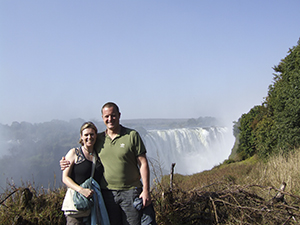 On arrival into Victoria Falls, you will be met and transferred to your Lodge. You have the remainder of the day at leisure. This evening you will meet your guide and the rest of the group for your pre-departure meeting. On arrival into Victoria Falls, you will be met and transferred to your Lodge. You have the remainder of the day at leisure. This evening you will meet your guide and the rest of the group for your pre-departure meeting.
|
Distance / Time: N/A
Overnight: A’Zambezi River Lodge or similar (rooms with en-suite bathrooms, swimming pool, bar & restaurant).
Meals: All meals at your own account.
|
DAYS 2 - 3;
(2 Nights)
VICTORIA FALLS TO CHOBE NATIONAL PARK, Botswana [Lodge] |
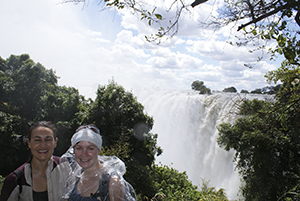 This morning your guide will take you on a tour of the mighty Victoria Falls, known by the local Kololo tribe as Mosi oa Tunya - “the smoke that thunders”. A mid-morning departure takes you from Victoria Falls in Zimbabwe on to Botswana for the next two nights. You will have the remainder of the day at leisure or to partake in optional activities. This morning your guide will take you on a tour of the mighty Victoria Falls, known by the local Kololo tribe as Mosi oa Tunya - “the smoke that thunders”. A mid-morning departure takes you from Victoria Falls in Zimbabwe on to Botswana for the next two nights. You will have the remainder of the day at leisure or to partake in optional activities.
The next day, we rise early for a morning game drive in the Chobe National Park, the second largest park in Botswana covering 10,566 km2. Chobe has one of the greatest concentrations of elephant found on the African continent. In the afternoon we go on a cruise on the Chobe River, a truly unforgettable experience and one of the best ways to view the wildlife and the spectacular sunset. |
Departure: 8am
Distance: 90 kms
Overnight: Chobe Safari Lodge or similar (rooms with en-suite bathrooms, swimming pool, bar & restaurant).
Meals Day 2: Breakfast at A’Zambezi River Lodge or similar, Lunch prepared by guide, Dinner at Chobe Safari Lodge or similar.
Meals Day 3: Breakfast at Chobe Safari Lodge or similar, Lunch and Dinner at your own account. |
DAY 4;
(1 Night)
CAPRIVI, Namibia [Tented Chalets] |
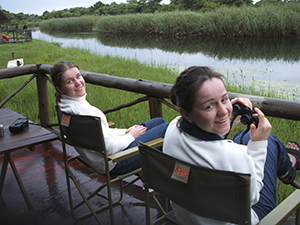 Leaving Botswana, we drive through Chobe National Park before crossing over into Namibia and driving through the Caprivi to our camp on the banks of the Kwando River. The afternoon is at leisure for a number of optional activities, or sit back and relax and take in the sights and sounds of the Kwando River. Leaving Botswana, we drive through Chobe National Park before crossing over into Namibia and driving through the Caprivi to our camp on the banks of the Kwando River. The afternoon is at leisure for a number of optional activities, or sit back and relax and take in the sights and sounds of the Kwando River.
|
Departure: 8am
Distance / Time: 265 kms
Overnight: Camp Kwando or similar (permanent tented chalets with en-suite bathrooms, swimming pool, bar & restaurant).
Meals: Breakfast at Chobe Safari Lodge or similar, Lunch prepared by the guide, Dinner prepared by the guide. |
DAYS 5 - 6; (2 Nights)
CAPRIVI TO OKAVANGO DELTA, Botswana [Permanent Tents] |
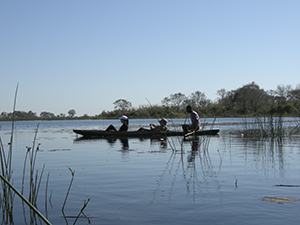 We leave our camp on the Caprivi for Etsha 13, on the western border of the Okavango Delta in Botswana. Unlike other deltas, it flows into the Kalahari Desert without reaching the coast, which makes it unique. Enroute to camp we will go on a game drive to the Mahangu National Park which is rich in fauna and flora. In the park you have the chance of spotting game such as sable and roan, elephants, hippos, buffalos, and many types of antelope. For bird watchers the Mahangu National Park offers more than 420 different bird species. We leave our camp on the Caprivi for Etsha 13, on the western border of the Okavango Delta in Botswana. Unlike other deltas, it flows into the Kalahari Desert without reaching the coast, which makes it unique. Enroute to camp we will go on a game drive to the Mahangu National Park which is rich in fauna and flora. In the park you have the chance of spotting game such as sable and roan, elephants, hippos, buffalos, and many types of antelope. For bird watchers the Mahangu National Park offers more than 420 different bird species.
The next day is spent exploring the network of water pathways floating through thick vegetation in mokoros (traditional dugout canoes), discovering a variety of birds and wildlife. We stop at a secluded island to take a 1½ hour guided walk hoping to spot elephants, waterbuck or other animals living in this water filled paradise. |
Departure: 8am
Distance / Time: 385 kms
Overnight: Guma Lagoon Camp or similar (permanent tents with en-suite
bathroom, bar area).
Meals Day 4: Breakfast at Camp Kwando or similar, Lunch prepared by the guide, Dinner prepared by the guide.
Meals Day 5: Breakfast at Guma Lagoon Camp or similar, Lunchpack from Guma Lagoon Camp, Dinner prepared by the guide. |
DAY 7;
(1 Night)
OKAVANGO DELTA TO KAVANGO RIVER, Namibia [Lodge] |
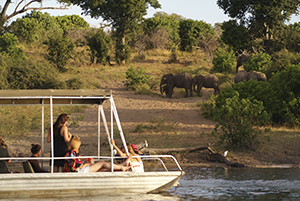 Leaving Botswana we make our way into Namibia and head along the Caprivi to Rundu. We make our way to Kaisosi River Lodge and spend a relaxing afternoon at our lodge on the banks of the Kavango River. Optional activities such as a visit to the Mbunza Living Museum, a traditional cultural school and communal business for the local Kavango people, or a sunset cruise are available. Alternatively just relax by the pool with a sundowner listening to the sounds of Mother Nature. Leaving Botswana we make our way into Namibia and head along the Caprivi to Rundu. We make our way to Kaisosi River Lodge and spend a relaxing afternoon at our lodge on the banks of the Kavango River. Optional activities such as a visit to the Mbunza Living Museum, a traditional cultural school and communal business for the local Kavango people, or a sunset cruise are available. Alternatively just relax by the pool with a sundowner listening to the sounds of Mother Nature.
|
Departure: 7am
Distance: 380 kms
Overnight: Kaisosi River Lodge (rooms with en-suite bathrooms,
swimming pool, bar & restaurant).
Meals: Breakfast at Guma Lagoon Camp or similar, Lunch prepared by guide, Dinner at your own account.
|
DAYS 8 - 10; (3 Nights)
ETOSHA NATIONAL PARK, Namibia [Lodge] |
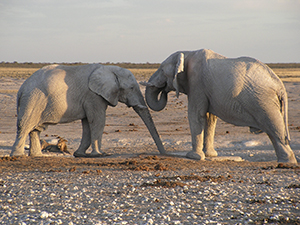 The following morning we head off to Etosha National Park. We fill the next 3 days with game drives in the hopes of spotting some of the Big Four as well as cheetah, giraffe, zebra and the numerous different types of antelope the park has to offer. Our nights are spent at the flood lit waterholes encountering the park’s various nocturnal animals as they come to drink. Etosha Game Park was declared a National Park in 1907 and it is home to approx. 114 mammal species, 340 bird species, 110 reptile species, 16 amphibian species and, surprisingly, one species of fish. The following morning we head off to Etosha National Park. We fill the next 3 days with game drives in the hopes of spotting some of the Big Four as well as cheetah, giraffe, zebra and the numerous different types of antelope the park has to offer. Our nights are spent at the flood lit waterholes encountering the park’s various nocturnal animals as they come to drink. Etosha Game Park was declared a National Park in 1907 and it is home to approx. 114 mammal species, 340 bird species, 110 reptile species, 16 amphibian species and, surprisingly, one species of fish.
|
Departure Day 8: 8am
Distance Day 8: 435kms
Overnight Day 8: Namutoni or similar (rooms with en-suite bathrooms,
swimming pool, bar & restaurant).
Meals: Breakfast Kaisosi Lodge or similar, Lunch prepared by the guide, Dinner for your own account.
Departure Day 9: 8am
Distance Day 9: 150 kms
Overnight Day 9: Okaukuejo or similar (rooms with en-suite bathrooms, swimming pool, bar & restaurant).
Meals Day 9: Breakfast Namutoni or similar, Lunch prepared by guide, Dinner for your own account.
Departure Day 10: 8am
Distance Day 10: 100 kms
Overnight Day 10: Okaukuejo or similar (rooms with en-suite bathrooms,
swimming pool, bar & restaurant).
Meals Day 10: Breakfast at Okaukuejo or similar, Lunch prepared by guide, Dinner at Okaukeujo or similar. |
DAY 11; (1 Night)
KAMANJAB - HIMBA EXPERIENCE, Namibia [Rest Camp] |
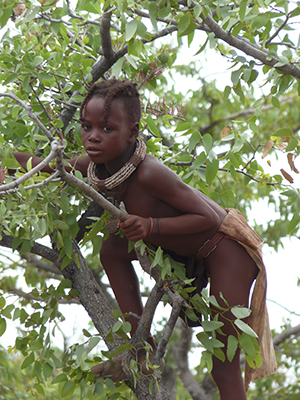 We leave the wild animals of Etosha behind and move onto the spectacular scenery of Damaraland. Our final destination for the day will be Kamanjab. Depending on the time of arrival we go and explore a traditional Himba village this afternoon or the next morning. This will be a journey of culture exchange, learning and understanding the ways of the last traditional tribe in Namibia, the Ova-Himba. We leave the wild animals of Etosha behind and move onto the spectacular scenery of Damaraland. Our final destination for the day will be Kamanjab. Depending on the time of arrival we go and explore a traditional Himba village this afternoon or the next morning. This will be a journey of culture exchange, learning and understanding the ways of the last traditional tribe in Namibia, the Ova-Himba.
|
Departure: 7am
Distance / Time: 280 kms
Overnight: Oppi Koppi Restcamp or similar (rooms with en-suite
bathrooms, swimming pool, bar & restaurant).
Meals: Breakfast at Okaukuejo or similar, Lunch prepared by the guide, Dinner at Oppi Koppi Restcamp or similar. |
DAY 12; (1 Night)
TWYFELFONTEIN, PETRIFIED FORST AND BRANDBERG, Namibia [Lodge] |
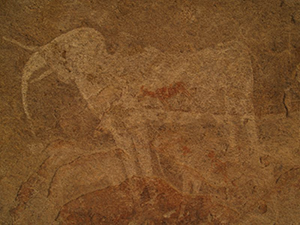 On our journey today we will stop to see ancient Bushmen paintings at Twyfelfontein as well as the Petrified Forest, the trees of which are estimated to be 250 million years old. Twyfelfontein was named a World Heritage site in 2007, the first in the country. We continue to Brandberg, the highest mountain in Namibia. Either this afternoon or the next morning we take a walk to visit the “White Lady” one of the most famous rock paintings in the area. The footpath to the site offers spectacular views over the plains of Damaraland. On our journey today we will stop to see ancient Bushmen paintings at Twyfelfontein as well as the Petrified Forest, the trees of which are estimated to be 250 million years old. Twyfelfontein was named a World Heritage site in 2007, the first in the country. We continue to Brandberg, the highest mountain in Namibia. Either this afternoon or the next morning we take a walk to visit the “White Lady” one of the most famous rock paintings in the area. The footpath to the site offers spectacular views over the plains of Damaraland.
|
Departure: 7am
Distance / Time: 350 kms
Overnight: Brandberg White Lady Lodge or similar (rooms with ensuite
bathroom, swimming pool, bar & restaurant).
Meals: Breakfast at Oppi Koppi Restcamp or similar, Lunch prepared by the guide, Dinner at Brandberg White Lady Lodge or similar. |
DAYS 13 - 14; (2 Nights)
CAPE CROSS COLONY AND SWAKOPMUND, Namibia [Hotel] |
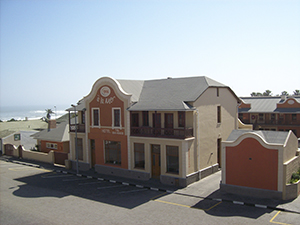 We move westwards across the flat desert plains to reach the cold Atlantic coastline. As we follow the Skeleton Coast on our way to Swakopmund we visit Cape Cross - the largest breeding place of the Cape Fur Seals. We arrive into the charming coastal town of Swakopmund, where you will have the opportunity to partake in a few of the many optional activities that are offered, over the next two days. Alternatively just soak up the atmosphere of this little quaint German town and enjoy its beauty and beaches. We move westwards across the flat desert plains to reach the cold Atlantic coastline. As we follow the Skeleton Coast on our way to Swakopmund we visit Cape Cross - the largest breeding place of the Cape Fur Seals. We arrive into the charming coastal town of Swakopmund, where you will have the opportunity to partake in a few of the many optional activities that are offered, over the next two days. Alternatively just soak up the atmosphere of this little quaint German town and enjoy its beauty and beaches.
|
Departure: 8am
Distance / Time: 330 kms
Overnight: Hotel A La Mer or similar (standard rooms with en-suite bathrooms).
Meals Day 13: Breakfast at Brandberg White Lady Lodge or similar, Lunch prepared by the guide, Dinner at your own account.
Meals Day 14: Breakfast at Hotel A La Mer or similar, Lunch and Dinner at your own account.
|
DAYS 15 - 16; (2 Nights)
NAMIB NAUKLUFT NATIONAL PARK AND SOSSUSVLEI, Namibia [Chalets] |
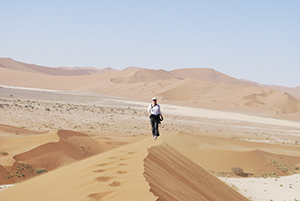 The day is spent driving through the Namib Naukluft National Park on our way to Sossusvlei. The Namib-Naukluft Desert is an ancient land with an ageless spirit. It is home to some of the rarest plant and animal species in the world and sightings of this flora and fauna on a Namibian safari are a must. The animals of this harsh landscape include the oryx, springbok and Hartmann’s Mountain Zebra. The day is spent driving through the Namib Naukluft National Park on our way to Sossusvlei. The Namib-Naukluft Desert is an ancient land with an ageless spirit. It is home to some of the rarest plant and animal species in the world and sightings of this flora and fauna on a Namibian safari are a must. The animals of this harsh landscape include the oryx, springbok and Hartmann’s Mountain Zebra.
The next morning we need to wake up early to visit the world’s highest sand dunes at Sossusvlei and Deadvlei. These dunes, which can reach heights of over 300 m, are absolutely spectacular and provide for a fantastic photo opportunity. With luck, there may even be water in the vlei (lake). We also stop to view the Sesriem Canyon, which was carved millions of years ago by the Tsauchab River. |
Departures: 8am
Distance / Time Day 15: 295 kms
Distance / Time Day 16: 230 kms
Overnight: Agama River Camp or similar (chalets with en-suite bathrooms, swimming pool, bar & restaurant).
Meals Day 15: Breakfast at Hotel A La Mer or similar, Lunch prepared by the guide, Dinner prepared by the guide.
Meals Day 16: Breakfast packs from Agama River Camp or similar, Lunch prepared by the guide, Dinner for your own account. |
DAY 17; (1 Night)
FISH RIVER CANYON, Namibia [Hotel] |
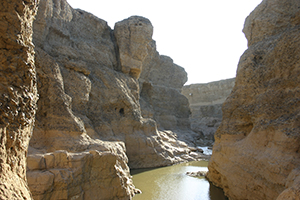 Today is a long driving day. We travel south to our accommodation which is situated close to the Fish River Canyon, the second largest canyon on earth. Later in the evening we take in another perfect African sunset with the magnificent views and scenery along the edge of the canyon. Today is a long driving day. We travel south to our accommodation which is situated close to the Fish River Canyon, the second largest canyon on earth. Later in the evening we take in another perfect African sunset with the magnificent views and scenery along the edge of the canyon.
|
Departure: 7am
Distance / Time: 600 kms
Overnight: Canyon Roadhouse or similar (rooms with en-suite bathrooms, swimming pool, bar & restaurant).
Meals: Breakfast at Agama River Camp or similar, Lunch prepared by the guide, Dinner at Canon Roadhouse or similar.
|
DAYS 18 - 19; (2 Nights)
THE ORANGE RIVER, Namibia [Chalets] |
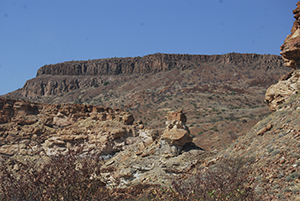 We leave this morning for our camp on the banks of the Orange River, the natural border between South Africa and Namibia. We stop at Ai-Ais, where thermal water rich in sulphates and fluorides and with a temperature of approx. 60°C gushes forth from the springs. In the Nama language, "Ai-Ais" means "burning water". The next day the only travelling is done in a canoe. Put your feet up and relax as the currents take you downstream the Orange River – mind the rapids though! We leave this morning for our camp on the banks of the Orange River, the natural border between South Africa and Namibia. We stop at Ai-Ais, where thermal water rich in sulphates and fluorides and with a temperature of approx. 60°C gushes forth from the springs. In the Nama language, "Ai-Ais" means "burning water". The next day the only travelling is done in a canoe. Put your feet up and relax as the currents take you downstream the Orange River – mind the rapids though!
|
Departure: 9am
Distance / Time: 220 kms
Overnight: Felix Unite Camp Provenance or similar (chalets with ensuite
bathrooms, swimming pool, bar).
Meals Day 18: Breakfast at Canon Roadhouse or similar, Lunch prepared by the guide, Dinner prepared by the guide.
Meals Day 19: Breakfast at Felix Unite Camp or similar, Lunch pack prepared by Felix Unite, Dinner prepared by the guide. |
DAY 20; (1 Night)
THE ORANGE RIVER TO CEDARBERG, SOUTH AFRICA [Lodge] |
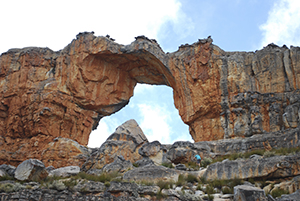 We cross the border into South Africa and make our way down the West Coast. If you are travelling in spring you will see the spectacular carpets of wildflowers in the famous Namaqualand region. We arrive in Clanwilliam in the late afternoon, one of the ten oldest towns in the country, nestled at the foot of the Cedarberg Mountains. We cross the border into South Africa and make our way down the West Coast. If you are travelling in spring you will see the spectacular carpets of wildflowers in the famous Namaqualand region. We arrive in Clanwilliam in the late afternoon, one of the ten oldest towns in the country, nestled at the foot of the Cedarberg Mountains.
|
Departure: 8am
Distance / Time: 470 kms
Overnight: Clanwilliam Lodge or similar (rooms with en-suite
bathrooms, restaurant, bar & swimming pool).
Meals: Breakfast at Felix Unite or similar, Lunch prepared by the guide, Dinner at Clanwilliam Lodge or similar. |
DAY 21; (1 Night)
CEDARBERG MOUNTAINS to CAPE TOWN, SOUTH AFRICA [Hotel] |
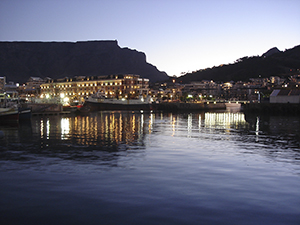 Before heading off you can enjoy a local favourite of Rooibos tea tasting. Rooibos is indigenous to the Western Cape and has major nutritional and health benefits. A day drive through the mountains takes us to our final destination, Cape Town. We stop at the beach on the Atlantic Ocean to view Table Mountain across the bay. Before heading off you can enjoy a local favourite of Rooibos tea tasting. Rooibos is indigenous to the Western Cape and has major nutritional and health benefits. A day drive through the mountains takes us to our final destination, Cape Town. We stop at the beach on the Atlantic Ocean to view Table Mountain across the bay. |
Departure: 10am
Distance / Time: 230 kms
Overnight: The Townhouse Hotel or similar (rooms with en-suite
bathrooms, bar and restaurant).
Meals: Breakfast at Clanwilliam Lodge or similar, Lunch prepared by the guide, Dinner at your own account. |
DAY 22;
CAPE TOWN, SOUTH AFRICA [END OF TOUR] |
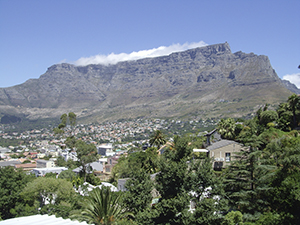 Our safari ends after breakfast. We hope to welcome you again one day on another of
our African adventures. Our safari ends after breakfast. We hope to welcome you again one day on another of
our African adventures.
|
Departure: N/A
Distance / Time: N/A
Overnight: N/A
Meals: Breakfast at Townhouse Hotel or similar. |
Note: The accommodation specified in the itinerary is a guide only and is subject to availability. Alternatives will be nearby and of a similar standard.
 Top Top
CLICK TO SEE DEPARTURE DATES
Included
Twenty-one nghts in fixed accommodation, all transport in fully equipped vehicle, game drives and activities as mentioned, meals as per itinerary, park entrance fees, experienced local guide.
Excluded
Travel insurance, flights, pre and post tour accommodation, optional activities, all drinks, tips and curios, all personal expenses.
Departure
The Southern Experience Safari departs from A’Zambezi River Lodge in Victoria Falls.
Please note that the daily departure times are a guideline only and are subject to change due to seasonal variations, as well as unforeseen circumstances. The final decision rests with your guide who will advise you at what time you will be departing each day.
On the evening of day 1, there will be a meeting presented by your guide, at 18h00 at your lodge. It is imperative that all clients attend this meeting so as not to miss out on any critical information.
Whilst it is our every intention to adhere to the above mentioned itinerary, there may on occasion be a necessity to make alterations in order to make the tour more enjoyable or practical. Therefore please treat the itinerary as a guide only.
Transport
Fully equipped Toyota Land Cruisers, 12-seater 4x4 safari vehicles or other appropriate vehicles with comfortable seating, large windows for game viewing, a music- and PA-system and air-conditioning. All luggage, besides hand luggage and photo equipment, is carried on the vehicle or trailer roof racks to ensure maximum comfort in the vehicle. For transfers between Kasane and Victoria Falls (or vice versa), 2x4 vehicles may be utilised.
Travelling Times and Distances
All travelling times are affected by road conditions, border crossings, detours and weather conditions, therefore on certain days travelling times may be longer than anticipated especially where there is a lot of distance to be covered. Please keep in mind that the time it takes to travel 100 km in your home country is not equivalent to the time it takes to travel 100 km on African roads, therefore we encourage you to sit back
and enjoy the spectacular scenery Africa has to offer. Where possible additional stops
will be made to ensure your travelling comfort at all times.
Accommodation
We make use of mid-range typical African standard lodge accommodation. Accommodation is situated either in National Parks, on the banks of a river, or in other places of interest. The accommodation will be a mix of lodges, chalets and tented camps. All of them offer a private bathroom with a shower/bath and toilet. Some properties are equipped with swimming pools and/or bar and restaurant areas.
Local Payment
A local payment is required on your safari and will be collected by your guide on the day of departure. The local payment is part of the overall tour cost and is used to pay some of the day to day operational costs that are incurred while we are on the road.
We try to prepay as many of the costs as possible however in some cases cash payment on arrival is the only option as some of the attractions we visit on safari only accept cash. Examples include park fees at most of the national parks, a few accommodations or camp sites and any local food markets we visit to stock up on fresh produce during the tour as well as local guides. Your tour guide is given a garage card to pay for fuel, however this is only valid for use in South Africa and certain parts of Namibia therefore any other fuel purchases also need to be paid for in cash.
The local payment also ensures that a portion of your tour cost actually goes directly to the countries you visit, thus benefiting local communities as well as contributing to conservation of the areas we visit. Essentially having a local payment means your tour price is a bit lower and give you a more inclusive experience.
Visas
The onus is on the client to organize all visas required for clients to visit Zimbabwe, Botswana, Namibia and South Africa prior to departure.
Information on Areas Visited
ZIMBABWE
This is a country blessed with great natural beauty, game reserves and mineral wealth.
The diverse landscape changes from mountainous to wilderness to typical Bushveld. The
country is also home to large animals and a large bird population. Zimbabwe is a country
located in the southern part of the continent of Africa, between the Victoria Falls,
Zambezi river, Kariba Dam and the Limpopo river. Zimbabwe is bordered by South Africa
to the south, Botswana to the west, Zambia to the north and Mozambique to the east.
Victoria Falls
'So lovely it must have been gazed upon by angels in their flight' said David Livingstone of the supreme Mosi-oa-Tunya ('The smoke that thunders'). This legendary traveler first
saw the Falls from the Zambian side and his memory is enshrined in the nearby town of
Livingstone. The views from the Zimbabwean & Zambian side are quite different, varying
dramatically depending on the season and water flow.
The Falls are over a mile in length and boast the largest curtain of water in the world -
over 500 million liters or water per minute go over the falls and drop 100 m at Rainbow
Falls on the Zambian side. Not surprisingly is it the seventh wonder of the world and fast
becoming one of the top adventure destinations in the world.
The river is divided into a series of braided channels that descend in many separate falls.
Below the Falls the river enters a narrow series of gorges, which represent locations
successively occupied by the falls earlier in their history. Since the uplifting of the
Makgadikgadi Pan area some two million years ago, the Zambezi River has been cutting
through the basalt base rock, exploiting weak fissures, and forming a series of retreating
gorges. Seven previous waterfalls occupied the seven gorges below the present falls,
and Devil's Cataract in Zimbabwe is where the next cut back will form a new waterfall
that will eventually leave the present falls lip high above the river in the gorge below.
BOTSWANA
The San were among the first human inhabitants of this region before the Setswana migrated southwards and slowly occupied the region from the 16th century onwards, until early in the 19th century. By mid-century missionaries arrived, including David Livingstone and Robert Moffat, and by 1885 the territory was a British protectorate. Botswana gained its independence in 1966 and has been the most stable democracy in Africa. The first president ruled from 1966 until his death in 1980, the second till 1994 (re-elected twice, then resigned) and the third from 1998.
The country has a strong currency with one of the highest per capita incomes in Africa,
maintains a neutral international political stance. It is heavily reliant on mining (especially
diamonds) & tourism and maintains close ties with its neighbor South Africa, an economic
powerhouse for the region.
Wildlife is abundant in Botswana and includes lion, giraffe, leopard, antelope, elephant, crocodile and ostriches. Botswana is semiarid and has an average annual (summer)
rainfall of 640 mm (about 25 in) in the north to less than 230 mm (less than 9 in) in the
Kalahari. Drought is therefore not uncommon and the vegetation is mostly savannah.
Geographically Botswana is relatively flat (the average elevation of about 1000 m) and
can be viewed (for all intents and purposes) as three major regions as follows:
Chobe National Park in the north, another outstanding wilderness area of enormous
diversity – lion and elephant can be viewed from river cruises or 4x4 game drives.
The Okavango Delta is a vast marshland and one of the largest inland river deltas in the
world – 15 000 km2 of wilderness and prime safari area. The Kalahari Desert in the central
and southwestern regions occupies over half the land area of Botswana. It is a mystical,
harsh and unspoiled landmass. The saltpans of north-central Botswana and the Tuli block in the far eastern corner of
Botswana are also areas of significance.
Chobe National Park
Chobe is approx. 11 000 km2 of wilderness area watered by the Chobe & Savuti Rivers
and thus attracting huge concentrations of game. This includes lion and some of the
highest concentration of elephant in Africa – an estimated population of around 25 000
in winter. Game viewing is renowned and in the Northern areas near Kasane, both the
riverboat game viewing experience and the 4x4 vehicle option are popular.
In addition the spectacular annual summer migrations of plains game, especially Zebra,
is a highlight, as well Giraffe, Warthog and numerous antelope including Sable, Roan,
Oribi, Reedbuck, Lechwe and the colourful Chobe Bushbuck.
Bird watching opportunities in Chobe are ample and include some 350 species including
the awesome African Fish Eagle, the rare Pell's Fishing Owl, saddle-billed storks, long-toed
Plovers, pink-backed Pelicans, African Skimmers, Bradfield's Hornbills and Carmine Beeeaters.
In addition, the sunsets are spectacular.
Okavango Delta
The Okavango Delta in northern Botswana near Maun incorporates the Moremi Game
Reserve and is a unique wildlife paradise - one of the finest in the world. It is one of the
largest inland river deltas in the world. This unsurpassed natural environment is a maze of
waterways, islands and reed banks creating a perfect place for lion, elephant, leopard,
buffalo, giraffe, hyena, wild dog, kudu, impala, roan, zebra, lechwe, hippo, and
crocodile, amongst others. There are 440 bird species in the delta and fish species are
also abundant, including tiger fish, sharp-toothed catfish, barbell and bream.
Travel through the swamps ands surrounding areas is generally by open 4x4 game
viewing vehicle or a peaceful meander in a 'Mokoro', a flat-bottomed dugout canoe.
The Delta is hot throughout the year with temperatures ranging from about 14°C in
January to 24°C in July. Rainfall averages 525 mm annually, but varies greatly from year
to year. Water levels and flooding reach a maximum between March and July, after
rains at the source and the usual 15 000 km2 can expand to approximately 22 000 km2 in
high-rainfall years.
NAMIBIA
'Namibia' means 'open plains' in the ancient Hottentots language. It is a sought after
tourist destination defined by endless sunshine, scenic beauty and unusual and
contrasting topography. Namibia is sandwiched between two deserts - the Namib
Desert, said to be the oldest in the world, on its western coastline and the Kalahari Desert
in the eastern interior. Northern Namibia features the great Etosha National Park, with the
countries largest concentration of game and in the south the majestic Fish River Canyon
plunges 550 m and extends for 160 km. Between these four highlights lies over 820 000
km2 (the size of France & Britain combined) of contrasting scenery.
The world's highest dunes are found in haunting scenery inspiring somber reflection. Prehistoric
rock art, the ancient fossil plant, Welwitschia mirabilis and fossilized dinosaur footprints are preserved in the ancient, rocky mountain ranges.
Many of the features of this country are of particular scientific interest and attract
scientists from all over the world.
Namibia is the first country in the world to include protection of the environment and
sustainable utilization of wildlife in its constitution. About 15,5% of the country has been
set-aside as national parks. In these areas, rare and endangered species of animals, birds and plant life are preserved and protected. They serve as a living reminder to us all, and to the generations of the future, of how it once was in Africa.
Caprivi
A part of the Western Caprivi previously known as the Golden Triangle is a pristine
wilderness area, practically untouched by any. The area was formerly under government
jurisdiction – a 'no man's land' so wild that both private landowners and even nature
conservation officials had no authority until the early-nineties. The land was finally
handed over to nature conservation officials who now have prominent presence in the
area. A spectacular part of this area is well known as 'The Horseshoe', a meandering part
of the Kwando River now cut-off to from the flow to form a horseshoe teeming with
game. A 10-12 km drive through swamp and savannah takes you directly there while the
return trip follows the Kwando River. Not only are hippos abundant in this area, but also a
resident pride of lions. The Horseshoe is also on the buffalo migration route north. Other
animals to be seen are elephant, giraffe, hyena, tebe, lechwe, kudu and over 400
identified bird species.
Etosha
Consisting of over 22 000 km2 of saline desert, savannah and woodlands, the Etosha
National Park is one of the largest game reserves in Africa and one of the major
sanctuaries for wildlife. Its definitive feature is the Etosha Pan, a vast shallow depression of
about 5 000 km2. This great, white expanse locals call 'great place of dry water', often
shimmers with mirages and herds of game can be seen within this eerie setting. There
are 144 mammal species in the park, including elephant, giraffe, blue wildebeest and
black rhino, predators such as lion, cheetah, leopard, wildcat, hyena and jackal. The
black rhino population of 300 is one of the few growing populations in the world and the
local elephants are reputed to be the largest in Africa - the tallest standing at 4m at the
shoulder. Their tusks however are relatively small due to genetic defects and mineral
deficiencies in their diet. The majestic eland, the tiny, shy Damara dik-dik (45 cm high)
and the striking gemsbok, with its dramatic black and white markings are common. Bird
life is prolific and some 340 species have been identified, including Namibia's national
bird, the vividly coloured crimson-breasted shrike. During the more rainy seasons Etosha is
also one of the most important breeding grounds for flamingos.
Etosha is also known for its expert game management and attentive protection of the
unspoiled environment.
Kamanjab Himba Village
The name Kamanjab means Rock and it has been directly translated from Otji-Herero. A
visit to the Himba Village of the very well-known guide and translator Jaco will take you
on a journey of cultural exchange, learning and understanding of the last traditional tribe
in Namibia, the Ova-Himba. Jaco is an Afrikaans speaking white male, but lives for
several years now with his Himba family and speaks Otji-Herero fluently. He was adopted
in the Himba culture by an old chief Tjskume Bhahona that lives in the mountains at
Onkongko near Opuwo. After spending a lot of time with his new family Jaco decided to
come home to his family farm near Kamanjab where he was still farming with goats,
sheep and nguni cattle, the old chief then asked Jaco if he can send some of his people
with him to come and help him on his farm, Cauas Okawa to look after his goats and
cattle. They built a traditional village for themselves and do their farming and also
planting during the raining season. Please take note that they only allow persons that are
really interested in the culture and want to have a cultural exchange, not only to take
photos and go. You'll experience the milking ceremony, find out more about their beliefs
around the holy fire and their ancestors, and their herbal medicine and smoke bath. The
meaning of jewelry pieces and hairstyles is to imitate the status of each tribe member
and their close relationship to nature, their cattle and their children.
Twyfelfontein
Twyfelfontein is known as Namibia's largest open-air art gallery exhibiting pre-historic
artists. One of Africa's richest collections of rock engravings is on display. It is believed
ancient hunters painted these Bushman Paintings, mostly of lions, giraffes and elephants,
while in wait for wild animals at the waterholes. Although the exact age of the paintings
are unknown, it is estimated that they are between a few hundred and several thousand
years old.
Burnt Mountain, south of Twyfelfontein is a panorama of desolation, with coloured rocks
contrasting vividly against the grey-black surroundings.
The Organ Pipes, a mass of basalt slabs in a ravine gouged out by a river, is another
geological curiosity in this area.
Brandberg
About 100 km further south lay the imposing Brandberg massif; the highest peak in
Namibia at 2574 m. Besides being a major challenge to rock climbers the Brandberg is
most famous for rock paintings. One of the paintings discovered in 1917, can be viewed
on an overhang in Maack's Shelter, named after this first discoverer. In 1955 however,
Breuil, a well-known French archaeologist and historian copied, described and named
the painting as the 'The White Lady', thinking that the figure resembled a lady of Greek or
Egyptian origin. Although 'The White Lady' has since been the subject of much
controversy, scientists now seem to agree that the painting portrays a young man. This is
due to the lower part of 'his' body being painted white, a magical hunting spell, as was
customary to the Himbas and the Hereros.
This area is also the haunt of the extremely rare Desert Elephant, one of the true natural
wonders of the word, surviving as they do in this thirsty land. This is also one of the few
places in the world where animals are completely wild in a mountain desert landscape.With the help of locals these elephants can be tracked – an experience not easily forgotten.
Cape Cross Seal Colony
The Cape Cross Seal Colony is north of Swakopmund. During breeding season as many
as 200 000 Cape fur seals (the world's largest fur seal) gather in the cold waters along this
coast. The numerous islets and isolated parts of the shore are used as nurseries for their
young.
Swakopmund
A true oasis and respite from the solemn desert and its monotonous heat. A seaside holiday resort full of old-world charm and modern amenities, from the quaint German
colonial influences to a funky Internet café. The tranquil setting includes promenades,
palm trees and beautifully tended public gardens, the Swakopmund museum (covering
natural history, mineralogy, botany, historical and ethnological aspects), the National
Marine & Research Centre, an aquarium, a public library, an Olympic sized, heated
indoor swimming pool and a grassed golf course in a desert setting. This 'middle of the
desert' feel is one of its attractions – one can enjoy the wild expanse of the adjacent
desert and sea and yet be within easy reach of the creature comforts of Swakopmund's
hotels, restaurants, bars and a much-needed laundries!
There is plenty to see and do and activities include quad biking, sand boarding, rock& surf fishing and skydiving. There is also a tannery, manufacturing well-known kudu leather
shoes, a brewery producing fine beers in the German tradition.
Namib-Naukluft National Park
The Namib-Naukluft National Park is an incredibly unusual and diverse 'superconservation'
area. There is nothing quite like it. It's probably the most unusual in the
world – an ancient land with an ageless spirit. It covers almost 50 000 km2 and is ranked
as the 4th largest in the world (the largest nature conservation area in Namibia) withlandscapes including an impressive mountain massif, desert plains, high sand dunes,
deep gorges and an estuarine lagoon. In truly African light show there is often clear and
sometimes sudden shift in the mood of the moment, as light, textures and shadows give
desert landscapes entirely new characters.
Survivors in this harsh landscape include the Oryx, springbok and zebra as well as the
Welwitschia mirabilis, an odd-looking desert shrub. One large, protected specimen is
estimated at 1 500 years old.
Sesriem
Erosion of many centuries has incised a narrow gorge through which the Tsauchab River
disappears dramatically down a steep gorge in the plain. This gorge, Sesriem Canyon,
about 1 km long with pools along the ways and a 30-40 m pool at its end. These pools of
water on a gravel bed in an otherwise arid region, attracts many birds and animals.
Sossusvlei
The visual spectacular in the Sossusvlei area is unsurpassed. Amongst the continuous
towering dunes as far as the eye can see is arguably the highlight of the Namib Desert,
the Sossusvlei, and an enormous clay-pan, enclosed by dunes. After a heavy rainfall, rare
in this area, the vlei fills with water and, as the clay layers are virtually impermeable to
water, a turquoise lake remains for quite some time.
The dunes and their rich tints vary from pale apricot to vivid reds and oranges, and
contrast vividly with the dazzling white surfaces of the white clay pans, or lakes, below.
During the rainy season one of the larger of these pans creates a haven for water birds,
often including flamingos. Even during the dry season, Oryx, springbok and ostriches can
be seen feeding off the sparse vegetation along the watercourses.
Fish River Canyon
The Fish River Canyon is surely one of the natural wonders of Africa, as well as the second
largest natural gorge on the continent. It is a 161 km long, 27 km wide ravine with a
maximum depth of 550 m, surrounded by high, forbidding cliffs, and gashed into the
plateau with startling abruptness. There are many awesome viewing sites to this
breathtaking and immensely powerful natural phenomenon, along a 56 km stretch
between its northernmost & southernmost points.
SOUTH AFRICA
Situated on the tip of the African continent, South Africa has often been described as a world in one country. It has a wealth of natural beauty, pristine wilderness areas, warm and friendly people, cosmopolitan cities and excellent infrastructure - making South Africa a favourite safari destination.
Namaqualand
Namaqualand is the famous flower wonderland. This desert landscape has extremely
sensitive veld conditions and fascinating plants unique to this area. Come the brief rainy
season the landscape undergoes a drastic transformation and the wild spring flowers
provide a spectacular flower show. Flowering starts north and spreads southward, but is
hard to predict and depends on weather conditions especially berg winds. The flower
season progresses as the weather becomes warmer.
Some of the specific areas of interest include the Skilpad Flower Reserve, an ideal place
to observe the spring flower spectacular during July and September. The Richtersveld
National Park desert reserve is known for its prolific bird life, while Goegap Nature Reserve
has 600 types of flower and 45 mammal species, especially the bat eared-fox.
Cedarberg
Two hours north of Cape Town, over the Piekenierskloof pass; you descend into a
different world – of wild, raw, dramatic beauty. The towering mountains, often a brilliant
purple in the late afternoon light, preside over fruit-filled valleys and true rock wilderness.
The magnitude of this wilderness is truly awe-inspiring.
Cape Town
Cape Town has traditionally been the gateway between Europe and Southern Africa
and this is still evident in its atmosphere, its playful character, its people and even its
architecture.
The 'Mother City' as it's known locally has no shortage of attractions. It's a magnetic,
multi-cultural city with an array of diverse offerings within a small, accessible area,
surrounded by spectacular topography. Spectacular beaches, mountains (incredibly
unique bio-diversity), hiking, water-sport, shopping centers, markets, theatres, museums,
historical & cultural attractions, a first-rate waterfront, galleries, night-clubs, restaurants
and an abundance of activities to suit all, are prolific in this world-class destination.
Although tastes vary, some of the more popular sights include the following:
Table Mountain
This 1086 m sandstone landmark dominates the city and has to be ascended! This is a
fantastic way to gain a perspective on the city, with some breathtaking views of the
peninsula, as well as an opportunity to experience the most concentrated, yet diverse,
ecosystems in the world. The mountain is home to more than 1450 species of plants,
many of which are not found anywhere else in the world, such as the Silver Tree and the
wild orchid Disa Uniflora. Table Mountain is classified as the smallest of the six floral
kingdoms of the world. The 'flat' top of the mountain is approximately nearly 3 km in
length and sees almost a million tourist & hikers per year.
Visitors to the top can choose the six-minute trip to the summit via the modern cable car,
one of the safest in the world, or alternatively make use of one of the 350 recognized
paths all over the mountain. The easiest and quickest of these is the popular Platteklip
Gorge route, a path up a ravine clearly visible on the front face of Table Mountain. The
summit boasts a modern restaurant, souvenir shop and postal service.
Robben Island
With 150 years of dark, incarceration history, including the 18-year imprisonment of its
most famous prisoner, Nelson Mandela, the island is a certain place of interest. After the
fall of apartheid, the island was eventually declared a national monument in 1996,
formerly opened its doors to the public in 1997, and declared an UNESCO world heritage
site in 1999.
The Robben Island experience begins at Nelson Mandela Gateway to Robben Island,
situated in the Clock Tower Precinct at the V&A Waterfront, where four ferries a day
leave for the island. Each round trip is three and a half hours long and includes a visit to
the maximum-security prison, a bus tour around the island and visits to the penguin
boardwalk and museum shop. A number of antelopes can also be spotted on the island.
Wine Routes
Constantia, a meager 20 minutes from the city centre, is the birthplace of the wine
farming industry in South Africa. Still today, five wine farms in this area produce worldclass
wines, recognized for their escalating quality.
Further from the city, a drive of approximately 45 minutes north from Cape Town brings
you to a region where grand mountains from a dramatic backdrop to lush vineyards and
historic gabled Cape Dutch homesteads.
Almost 100 wine farms on four wine routes in this region alone boast not only a multitude
of award winning wines, but also restaurants, wine tasting and activities. In the wine
regions visitors can also experience a number of quaint villages & towns (especially Paarl,
Stellenbosch & Franshoek), cheese shops, a crocodile farm, a cheetah rehabilitation
centre, hikes and rivers activities.
The Victoria & Alfred Waterfront
As one of the most successful developments in the history of Southern Africa, the Victoria & Alfred Waterfront is a comprehensive shopping and recreational destination ranking
amongst the best waterfronts in the world. It's Cape Town's most popular local attraction
and has over a million visitors per year, 70% of which are Capetonian.
An array of shops, markets, restaurants, cinemas, a theatre, boat trips, helicopter trips, a
brewery, hotels as well as a new residential development can all be found within walking
distance and surrounded by a working harbor.
Additional attractions worth a visit are the Waterfront Craft Market & the Red Shed craft
market, where visitors can watch artists & craftspeople produce as well as buy their
wares. The Two Ocean Aquarium offers a constantly updated peak into indigenous
Southern African fresh and seawater creatures. Next door to the aquarium the South
African Maritime Museum has the largest collection of model ships in the Southern
Hemisphere and some fascinating artifacts.
 Top Top
Please contact us for dates.
 Top Top  Return to Budget Safari Packages Return to Budget Safari Packages
|